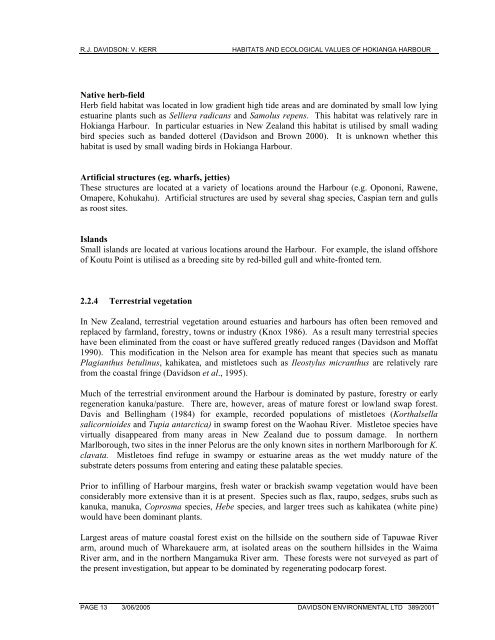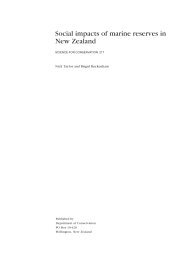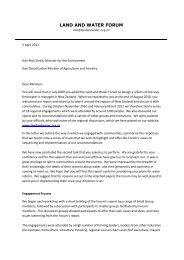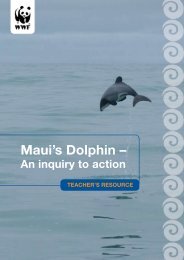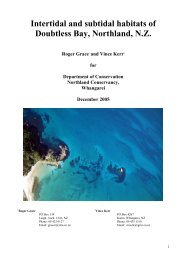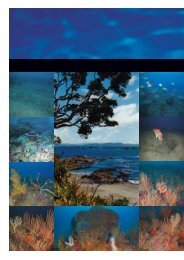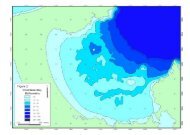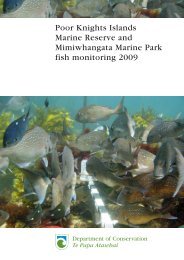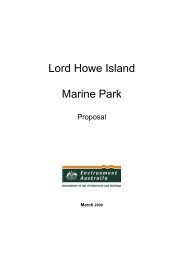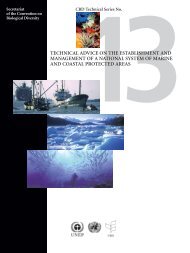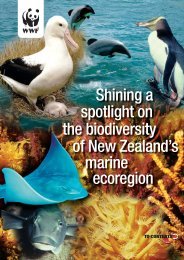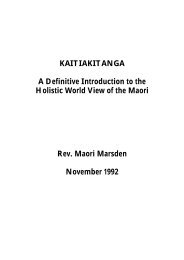Habitats and Ecological Values of the Hokianga ... - MarineNZ.org.nz
Habitats and Ecological Values of the Hokianga ... - MarineNZ.org.nz
Habitats and Ecological Values of the Hokianga ... - MarineNZ.org.nz
You also want an ePaper? Increase the reach of your titles
YUMPU automatically turns print PDFs into web optimized ePapers that Google loves.
R.J. DAVIDSON: V. KERR<br />
HABITATS AND ECOLOGICAL VALUES OF HOKIANGA HARBOUR<br />
Native herb-field<br />
Herb field habitat was located in low gradient high tide areas <strong>and</strong> are dominated by small low lying<br />
estuarine plants such as Selliera radicans <strong>and</strong> Samolus repens. This habitat was relatively rare in<br />
<strong>Hokianga</strong> Harbour. In particular estuaries in New Zeal<strong>and</strong> this habitat is utilised by small wading<br />
bird species such as b<strong>and</strong>ed dotterel (Davidson <strong>and</strong> Brown 2000). It is unknown whe<strong>the</strong>r this<br />
habitat is used by small wading birds in <strong>Hokianga</strong> Harbour.<br />
Artificial structures (eg. wharfs, jetties)<br />
These structures are located at a variety <strong>of</strong> locations around <strong>the</strong> Harbour (e.g. Opononi, Rawene,<br />
Omapere, Kohukahu). Artificial structures are used by several shag species, Caspian tern <strong>and</strong> gulls<br />
as roost sites.<br />
Isl<strong>and</strong>s<br />
Small isl<strong>and</strong>s are located at various locations around <strong>the</strong> Harbour. For example, <strong>the</strong> isl<strong>and</strong> <strong>of</strong>fshore<br />
<strong>of</strong> Koutu Point is utilised as a breeding site by red-billed gull <strong>and</strong> white-fronted tern.<br />
2.2.4 Terrestrial vegetation<br />
In New Zeal<strong>and</strong>, terrestrial vegetation around estuaries <strong>and</strong> harbours has <strong>of</strong>ten been removed <strong>and</strong><br />
replaced by farml<strong>and</strong>, forestry, towns or industry (Knox 1986). As a result many terrestrial species<br />
have been eliminated from <strong>the</strong> coast or have suffered greatly reduced ranges (Davidson <strong>and</strong> M<strong>of</strong>fat<br />
1990). This modification in <strong>the</strong> Nelson area for example has meant that species such as manatu<br />
Plagianthus betulinus, kahikatea, <strong>and</strong> mistletoes such as Ileostylus micranthus are relatively rare<br />
from <strong>the</strong> coastal fringe (Davidson et al., 1995).<br />
Much <strong>of</strong> <strong>the</strong> terrestrial environment around <strong>the</strong> Harbour is dominated by pasture, forestry or early<br />
regeneration kanuka/pasture. There are, however, areas <strong>of</strong> mature forest or lowl<strong>and</strong> swap forest.<br />
Davis <strong>and</strong> Bellingham (1984) for example, recorded populations <strong>of</strong> mistletoes (Korthalsella<br />
salicornioides <strong>and</strong> Tupia antarctica) in swamp forest on <strong>the</strong> Waohau River. Mistletoe species have<br />
virtually disappeared from many areas in New Zeal<strong>and</strong> due to possum damage. In nor<strong>the</strong>rn<br />
Marlborough, two sites in <strong>the</strong> inner Pelorus are <strong>the</strong> only known sites in nor<strong>the</strong>rn Marlborough for K.<br />
clavata. Mistletoes find refuge in swampy or estuarine areas as <strong>the</strong> wet muddy nature <strong>of</strong> <strong>the</strong><br />
substrate deters possums from entering <strong>and</strong> eating <strong>the</strong>se palatable species.<br />
Prior to infilling <strong>of</strong> Harbour margins, fresh water or brackish swamp vegetation would have been<br />
considerably more extensive than it is at present. Species such as flax, raupo, sedges, srubs such as<br />
kanuka, manuka, Coprosma species, Hebe species, <strong>and</strong> larger trees such as kahikatea (white pine)<br />
would have been dominant plants.<br />
Largest areas <strong>of</strong> mature coastal forest exist on <strong>the</strong> hillside on <strong>the</strong> sou<strong>the</strong>rn side <strong>of</strong> Tapuwae River<br />
arm, around much <strong>of</strong> Wharekauere arm, at isolated areas on <strong>the</strong> sou<strong>the</strong>rn hillsides in <strong>the</strong> Waima<br />
River arm, <strong>and</strong> in <strong>the</strong> nor<strong>the</strong>rn Mangamuka River arm. These forests were not surveyed as part <strong>of</strong><br />
<strong>the</strong> present investigation, but appear to be dominated by regenerating podocarp forest.<br />
PAGE 13 3/06/2005 DAVIDSON ENVIRONMENTAL LTD 389/2001


